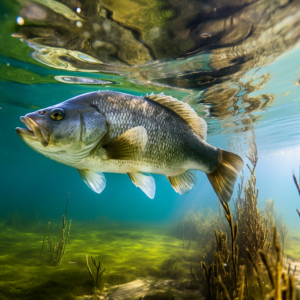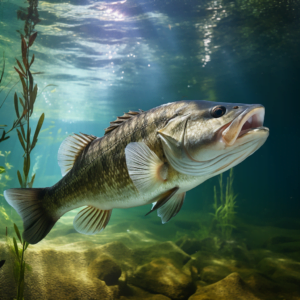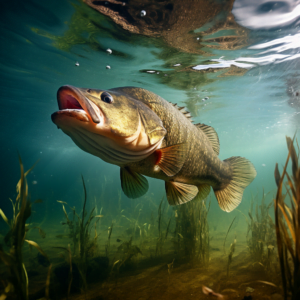Have you ever wondered about the eating habits of black bass? Well, you’re in luck! In this article, we will explore the carnivorous behavior of black bass in detail. By the time you finish reading, you’ll have a better understanding of what these fish eat and how they obtain their food.
Black bass, also known as Micropterus, are indeed carnivores. They have a strong predatory nature and rely on a diet consisting mostly of other smaller fish. These bass are equipped with a mouth filled with sharp teeth, which they use to capture and consume their prey. Their ability to hunt and feed on other fish has made them highly successful predators in their aquatic habitats.
To further understand the carnivorous behavior of black bass, it’s important to consider how they hunt and locate their prey. Black bass are highly skilled at ambushing their victims. They have a keen sense of sight and can detect the slightest movement in the water. This allows them to patiently wait for an opportunity to strike and catch their prey off guard. Additionally, they possess a lateral line system, which helps them sense vibrations in the water, further aiding in their hunting tactics.
In conclusion, black bass are indeed carnivores, and their predatory behavior is an essential part of their survival. They rely on their sharp teeth, keen sense of sight, and lateral line system to capture and consume other fish. Understanding the carnivorous behavior of black bass gives us insight into their ecological role and helps us appreciate the intricate dynamics of the underwater world. Stay tuned for more fascinating details in the upcoming sections of this article!
Introduction
Overview of Black Bass
Black bass is a freshwater fish species that belongs to the sunfish family. It is widely distributed across North America and is highly sought after by recreational anglers for its fighting ability and delicious taste. There are several species of black bass, including largemouth bass, smallmouth bass, and spotted bass. While they share some common characteristics, each species has its own unique traits and behaviors.
Importance of Studying Carnivorous Behavior
Understanding the carnivorous behavior of black bass is crucial for several reasons. Firstly, it helps us gain insights into their ecological role within their habitat. Black bass are apex predators in many freshwater systems, and their presence significantly impacts the food chain. Additionally, studying their carnivorous behavior can provide valuable information for the management and conservation of black bass populations, as well as the preservation of their prey species.
Physical Characteristics of Black Bass
Body Structure
Black bass have a streamlined body shape, which enables them to move swiftly through the water. They have a spindle-shaped body with a flattened head and a large mouth. Their lower jaw protrudes slightly, giving them a distinctive appearance. The body of a black bass is covered in scales, which vary in color depending on the species and the environment they inhabit.
Coloration and Camouflage
The coloration of black bass is highly variable, allowing them to blend in with their surroundings. Largemouth bass, for example, typically have a dark greenish color on their back, fading to a lighter green or yellow on their sides and belly. This coloration helps them conceal themselves in underwater vegetation, making them less visible to both prey and potential predators.
Diet of Black Bass
Carnivorous Nature
Black bass are primarily carnivorous, meaning they primarily feed on other animals. Their diet consists mainly of small fish, crustaceans, and insects. As apex predators, they play a vital role in controlling the populations of their prey species, thus helping to maintain a balanced ecosystem.
Prey Selection
Black bass have specific preferences when it comes to selecting their prey. While they are opportunistic feeders, they tend to target prey that is abundant and easily accessible. Additionally, their choice of prey may vary depending on factors such as the availability of certain species, water temperature, and habitat characteristics.
Foraging Behavior
Ambush Predation
Black bass are notorious ambush predators. They prefer to lie in wait, concealed by vegetation or underwater structure, and then strike suddenly when prey comes within range. This ambush strategy allows them to utilize their burst of speed and powerful jaws to capture their unsuspecting prey.
Hunting Techniques
In addition to ambush predation, black bass also employ other hunting techniques. They are known to actively search for prey by patrolling the edges of weed beds, rock formations, and other areas where potential prey may be hiding. Black bass are skilled at using their acute vision and lateral line system to detect the slightest movements of their prey.
Feeding Habits
Hunting Frequency
Black bass are active predators and engage in feeding behavior throughout the day, with increased activity during dawn and dusk. However, their feeding frequency may vary depending on factors such as water temperature, prey availability, and the bass’s own energy reserves.
Feeding Patterns
Black bass exhibit both solitary feeding behavior and cooperative feeding behavior. While they generally hunt alone, there are instances where multiple black bass work together to corral and trap schools of prey fish. This cooperative feeding behavior increases their hunting efficiency and allows them to capture a larger number of prey in a shorter period of time.
Prey Preference
Preferred Prey Species
Black bass have a wide range of preferred prey species, including small fish such as minnows, shad, and sunfish. They also feed on crayfish, insects, frogs, and even small mammals. The exact prey preference may vary depending on factors such as the specific black bass species and the habitat they inhabit.
Factors Influencing Prey Selection
Several factors influence the prey selection of black bass. These include the availability and abundance of certain prey species, the size and mobility of the prey, and the black bass’s own energy requirements. Additionally, water temperature and seasonal changes can also influence their prey selection.
Ecosystem Impact
Role in Food Chain
Black bass play a crucial role in freshwater ecosystems as apex predators. By preying on smaller fish and keeping their populations in check, they help maintain the balance of the food chain. Their predatory behavior prevents certain prey species from becoming overabundant, which can have detrimental effects on the overall ecosystem health.
Effect on Prey Populations
While black bass are important regulators of prey populations, their predatory behavior can also have significant impacts on specific prey species. In some cases, their feeding activity may lead to declines in the abundance of certain fish populations, especially if those species are already under stress from other factors such as habitat loss or pollution.
Predator-Prey Interactions
Behavioral Adaptations
Black bass have evolved several behavioral adaptations to enhance their predatory success. Their ability to camouflage themselves allows them to remain hidden from both prey and predators. The structure of their body, with a large mouth and sharp teeth, enables them to capture and hold onto their prey securely. Additionally, black bass have an excellent sense of hearing and can detect the movements of their prey, even in low-light conditions.
Coexistence with Other Predators
Black bass coexist with a variety of other predators in their habitat. They share their environment with species such as pike, muskie, and walleye, which are also predatory fish. While there may be competition for food resources, each species has its own niche and feeding preferences, allowing them to coexist without significant conflicts.
Conservation Considerations
Managing Black Bass Populations
The management of black bass populations is essential to ensure their long-term sustainability. This includes implementing regulations and guidelines for recreational fishing, such as size limits and catch-and-release practices. Additionally, habitat conservation efforts, including the preservation of freshwater ecosystems and the restoration of degraded habitats, are crucial for maintaining healthy black bass populations.
Implications for Fisheries
Understanding the carnivorous behavior of black bass has important implications for fisheries management. By studying their feeding habits and prey preferences, fisheries managers can improve stocking programs, develop targeted fishing techniques, and implement strategies to protect vulnerable prey species. This information can help maintain a balanced and sustainable fishery for black bass and the species they interact with.
Conclusion
Summary of Carnivorous Behavior
In conclusion, black bass exhibit a range of carnivorous behaviors that contribute to their status as apex predators in freshwater ecosystems. Their physical characteristics, hunting techniques, and prey preferences have evolved to maximize their feeding efficiency and ensure their survival. By studying and understanding their carnivorous behavior, we can gain valuable insights into their ecological role and the impacts they have on their prey populations.
Future Research Directions
Further research is needed to continue expanding our knowledge of black bass’s carnivorous behavior. This includes investigating the factors that influence their prey selection, understanding their interactions with other predators, and evaluating the long-term effects of their feeding behavior on prey populations. By filling these knowledge gaps, we can further improve our management and conservation efforts for black bass and the ecosystems they inhabit




